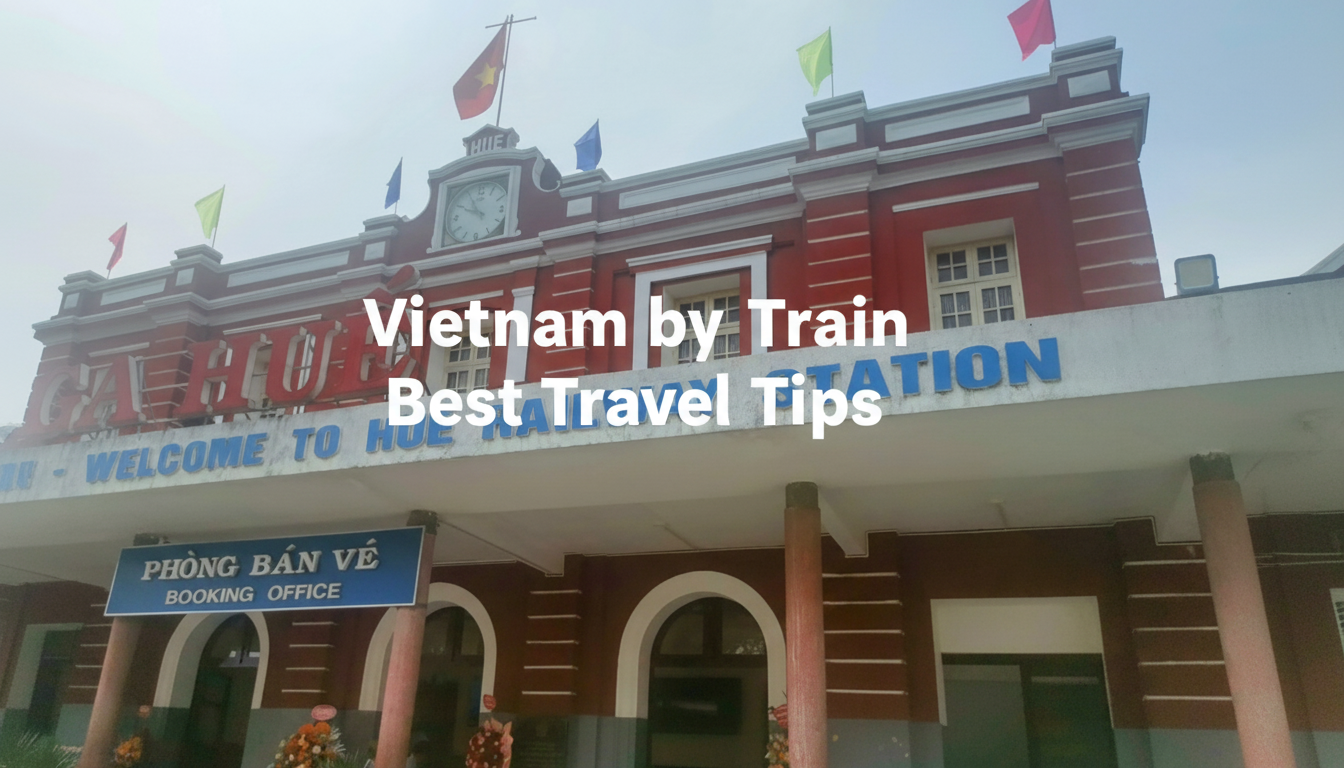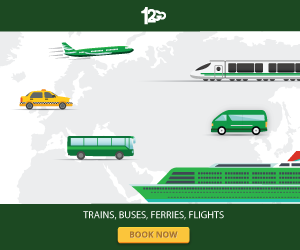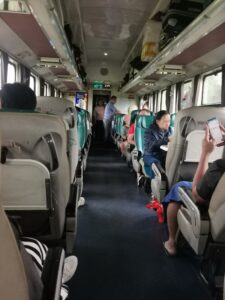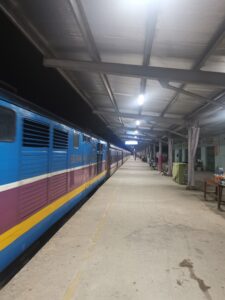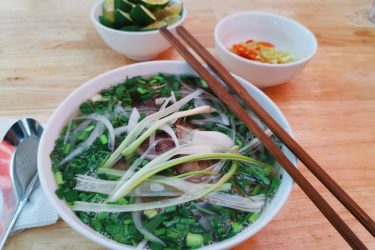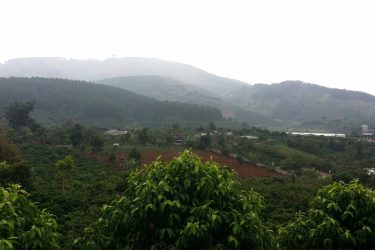Vietnam’s varied landscapes, vibrant towns, and rich culture can all be experienced in a singular and enthralling way when visiting by train. The railway network, which is mainly run by Vietnam Railways, spans more than 1,700 kilometers from Hanoi in the north to Ho Chi Minh City in the south. This trip, dubbed the Reunification Express, offers a beautiful and relaxing way to see Vietnam.
Vietnam’s railways come in a range of speeds and comfort levels, from budget-friendly hard seats to plush soft sleepers. The air-conditioned soft sleeper accommodations with cozy bedding are especially well-liked by travelers seeking a peaceful travel experience. All train trips in Vietnam, regardless of how comfortable they are, have one thing in common: they provide breath-taking views of the surrounding landscape, mountains, coastline, and rural villages—views that are frequently overlooked when taking an airline or bus.
The train ride via the Hai Van Pass, which offers stunning views of the South China Sea and the mountains, is one of the most picturesque parts of the trip between Da Nang and Hue. For many travelers, the train ride across Vietnam is worthwhile just because of this portion.
Aside from the breath-taking scenery, taking a train ride in Vietnam offers a genuine opportunity to engage with locals and gain insight into their everyday lives. A sense of companionship and cross-cultural interchange is fostered by passengers’ frequent sharing of food, tales, and travel advice.
To further support the growing trend of sustainable tourism, train travel is more environmentally beneficial than flying. The experience of travelling through Vietnam by rail is worthwhile, providing a combination of adventure, leisure, and cultural immersion that is difficult to duplicate by other modes of transportation, even with the sporadic delays and slower speed. Travelling through Vietnam by rail promises to be an amazing experience, whether you’re travelling alone, with a partner, or in a group.
Vietnam may be explored in a distinctive and picturesque way by rail. Here are some travel suggestions to ensure a seamless and pleasurable trip:
Book in Advance when Travelling by Train
When visiting Vietnam, purchasing rail tickets in advance is essential to a seamless and pleasurable trip. Vietnam’s trains can get very crowded, especially on weekends, holidays, and during peak travel seasons, notably the well-travelled Reunification Express route that connects Hanoi and Ho Chi Minh City. It’s imperative to make reservations in advance for the following reasons:
Guaranteed Seats: Vietnamese trains offer a variety of classes, ranging from hard seats to soft sleepers. During peak travel times, the more comfortable classes—such as soft sleepers and soft seats—tend to sell out quickly. Purchasing your tickets in advance guarantees that you will sit in your preferred class, which enhances the comfort of your journey, particularly on lengthy routes.
Better Planning: Having a better understanding of your train schedule helps you plan your itinerary more efficiently. While train fares in Vietnam are generally reasonably priced, purchasing tickets in advance can occasionally result in a lower price. Last-minute tickets may be more expensive, particularly for higher-class trains.
Economy of Cost: Vietnam’s rail rates are normally reasonably priced, but there are occasionally discounts available for early reservations. Tickets purchased at the last minute could cost more, particularly for more upscale lodging.
Easy accessibility: It is convenient to be able to buy tickets from the comfort of your home or hotel with online booking platforms and travel agents. This removes the need to deal with communication gaps and lengthy line-ups at train stations.
Peace of mind: Having your tickets secured in advance gives you piece of mind and lets you enjoy your trip without having to worry about availability. This is especially crucial if you have to travel on certain dates or have a limited schedule.
In conclusion, purchasing train tickets in advance guarantees the finest seats, allows you to organize your trip effectively, may result in cost savings, and gives you the confidence to travel throughout Vietnam. It’s an easy step that can make all the difference in your trip experience.
Choose the Right Class to Travel by Train
Selecting the appropriate class is crucial for guaranteeing a pleasant and stress-free rail ride in Vietnam. Vietnam Railways has a variety of classes to suit a range of tastes and price points. Knowing these possibilities will enable you to choose wisely depending on the nature of your trip.
Soft Sleeper: For extended travels, the soft sleeper is the most comfortable choice. Typically, these cabins feature four bunk beds, air conditioning, and occasionally even USB charging points. In comparison to other classes, there is a little more privacy and reasonably comfy bedding. For those looking for more comfort and a good night’s sleep, this class is ideal.
Intractable Sleeper
Hard Sleeper: A more affordable option is the hard sleeper, which has six berths per cabin. It’s not as cushioned as the soft sleeper, but it’s still a useful choice for lengthy travels. Although the cabins are noisier and less private, they provide an opportunity to meet more other travelers, which can be a fascinating cultural experience.
Soft Chair
For shorter flights, soft chairs are appropriate and comparable to airline economy class. Their air conditioning and padded seats provide a decent amount of comfort. For individuals who don’t need to sleep but yet want a relaxing journey, this class is a nice compromise.
Hard Seat: Hard chairs offer the least amount of padding and storage, making them the most basic and affordable choice. These are ideal for quick trips or travelers on a tight budget. Long excursions may find them rather unpleasant because of their small legroom and lack of padding.
Extra Things to Think About: The length of your trip, your spending limit, and your comfort level should all be taken into account while selecting the right class. A sleeper class is ideal for night-time travel, but soft seats might be good enough for daytime travel as well. It’s imperative to make reservations in advance, particularly for the more crowded and cozy classes, across careful class selection, you may guarantee comfort and convenience while travelling across Vietnam’s breath-taking scenery.
Pack Essentials for your Train Trip
When taking the train in Vietnam, having the proper items with you might make a big difference in your trip. This is a short list of essentials to make sure your travel is easy and comfortable:
Convenience and cleanliness
Travel blanket and pillow: Particularly for trips lasting more than one night in sleeping classes.
Comfortable Clothes: Airy, light-weight ensembles with a lightweight jacket to accommodate fluctuating temperatures.
Toiletries: Basic utilities can be lacking, so wet wipes, hand sanitizer, toilet paper, toothbrush, and toothpaste are essential.
Food and Beverages
Snacks and Water: Although dining cars and vendors are common on trains, it’s still helpful to have your own snacks and bottled water on hand to stay hydrated and nourished.
Reusable containers and cutlery are helpful for meals purchased at stations or on trains.
Entertainment and Connectivity
To kill time, especially on longer flights, use books, e-readers, or tablets.
Chargers and Power Banks: Make sure your electronics are powered up for the duration of the trip.
Headphones: For movies, music or noise cancellation.
Be Prepared for Delays when Travelling by Train
In Vietnam, being ready for delays is a crucial part of taking trains. Although the railway system provides beautiful and culturally diverse travel, delays in train schedules are a regular occurrence. Here’s how to prepare for any delays that might occur:
Flexible Itinerary
Build in Buffer Time: Give yourself extra time for any subsequent plans, such flights, tours, or hotel check-ins, once the train arrives.
Keep Up with: Check the most recent information and schedules for trains. Current information can be found via station announcements or online resources.
Entertainment and Comfort
Bring Entertainment: You can pass the time while waiting with films, music or books.
Comfort Items: If you find yourself waiting longer than you anticipated, a travel pillow, blanket, or cosy seating pad may come in handy.
Food and Hydration
Bring extra water and snacks to last through any delays as station amenities could be few or congested.
Reusable Bottle: Use a refillable water bottle to stay hydrated and cut down on trash.
Safety and Communication
Notify Contacts: If you anticipate being late, inform your friends, family, or lodging.
Invest in a portable charger to keep your phone and other electronics charged so you can stay in touch and enjoy entertainment.
Mindset
Remain optimistic and patient; delays are a part of the journey. Take the opportunity to unwind, take in the view, or have a conversation with other travelers.
You can make sure that your train trip in Vietnam is stress-free and pleasurable by planning ahead for any delays. You can use unplanned wait times as an opportunity to relax and think.
Secure your Belongings when Travelling by Train
Ensuring the safety of your possessions is crucial for a worry-free rail ride in Vietnam. Here are some useful advice on how to keep your belongings secure:
Secure Luggage
Locks: To prevent theft, lock your bags using padlocks. For ease, combination locks are preferred by many travelers.
Storage of Baggage: In sleeper compartments, place heavier luggage under chairs or on racks. If at all possible, fasten them to fixed structures using cable locks.
Keep Valuables Close
Compact, Lockable Bag: Always carry a tiny, lockable bag with you to store valuables like cash, passports, and devices.
Wearable Storage: For further security, money belts or neck pouches can be tucked under clothes.
Remain Vigilant
Be Aware of Your Environment: Keep an eye out for your possessions, particularly when the train stops at stations and passengers are getting on or off.
Dividends: Be kind but watchful in shared quarters. If you need to step away, trustworthy fellow travelers can keep an eye on your stuff.
Distribute Valuables
Items Dispersed: Don’t store all of your valuables in one location. To reduce the chance of theft, divide them across your luggage.
Use Technology
Trackers: For crucial goods, think about utilizing Bluetooth trackers, which can notify you if they unexpectedly move away from you.
Document Copies: Store digital copies of critical papers in cloud storage, such as passports and tickets.
By adopting these safety measures, you may relax and enjoy Vietnam’s stunning scenery and diverse cultures, knowing that your possessions are safe.
Experience the Local Cuisine when Travelling by Train
A fun aspect of travelling by rail in Vietnam is sampling the local cuisine, which provides a flavor of the nation’s varied culinary traditions. Here are some ideas for enjoying these distinct flavors when travelling:
Dining Car on Board
Local Cuisine: A wide range of Vietnamese cuisine, including pho (noodle soup), banh mi (Vietnamese sandwich), and com tam (broken rice), are served in the dining cars of several trains. These affordable lunches offer you the opportunity to experience real flavors while on the road.
Station Suppliers
Fresh and Delicious: Vendors board the train at several stops to sell freshly made snacks and meals. Boiled corn, fresh fruit, sticky rice with pork and banh bao (steamed buns) are all popular dishes. This is a great chance to sample some street food from the area.
Provide Your Own
Market Purchases: Get traditional snacks and lunches at neighborhood markets or street food vendors before to your travels. You can add treats to your train travel, like as fried pastries, exotic fruits, and spring rolls.
Social Meals
Meal Sharing: Having a meal together with other travelers might make your trip more enjoyable. It’s a popular custom in Vietnam and a wonderful way to meet new people and discover more about the cuisine of the region.
Drinking plenty of water and keeping clean
Making Safe Decisions: Constantly make sure the food you buy is cleanly prepared and fresh. Because train rides can be lengthy and exhausting, bring bottled water to stay hydrated.
Savoring regional cuisine on your train ride through Vietnam will not only quench your appetite but also allow you to fully experience the culture and cuisine of the nation, adding even more special memories to your vacation.
Enjoy the Scenery when Travelling Train
One of the most satisfying parts of the trip is taking in the beauty when travelling by rail in Vietnam. Vietnam’s train system provides a first-hand view of the stunning and varied country’s surroundings.
Diverse Landscapes
Coastline Views: There is breath-taking coastline scenery to be seen on routes like the one that passes through the Hai Van Pass between Da Nang and Hue. You’ll see rocky cliffs, sandy beaches, and blue oceans.
Beautiful countryside: When you drive into the heartland of rural America, you’ll discover charming towns, lush rice paddies, and farmers working their crops. A taste of traditional Vietnamese living can be seen in these scenes.
Mountainous Terrains: Travelling through the Central Highlands or the northern routes close to Sapa offer breath-taking views of flowing rivers, thick forests, and majestic mountain ranges.
Comfortable Viewing
Window Seats: Reserve a window seat in advance for the greatest experience. A lot of soft seat and sleeper classes have big windows for clear views.
Unwind and Take it all in: Take advantage of the slower train travel speed to unwind and take it all in. Bring binoculars or a camera to record or improve your viewing experience.
Perspectives on Culture
Travelling through Towns: Taking in the vibrant marketplaces, venerable temples, and everyday town life along the route enhances your journey.
Seasonal Changes: The scenery is depicted differently depending on the season, with golden fields at harvest time and lush foliage throughout the wet season.
When travelling by train in Vietnam, taking in the environment transforms the experience into an enthralling visual voyage that provides a close-up view of the nation’s stunning natural surroundings and diverse cultural heritage.
Interact with Locals when Travelling by Train
Engaging with locals throughout your rail travel in Vietnam enhances your experience by providing you with personal connections and cultural insights. To maximize these exchanges, follow these tips:
Be open and Friendly
Greet and Smile: Saying “xin chào” (hello) and smiling warmly can help to break the ice and start a nice discussion.
Pick Up Simple Phrases: Being able to communicate in Vietnamese is respectful and can assist overcome linguistic barriers. Sayings like “tạm biệt” (goodbye) and “cảm ơn” (thank you) are common and appreciated.
Share Stories and Food
Cultural exchange: Tell tales of your upbringing and life experiences. Locals like sharing stories and are frequently interested in other cultures.
Food Sharing: Giving and receiving food is a typical friendly gesture. Mutual understanding and meaningful conversations might result from sharing meals or snacks.
Ask Questions
Discover Local Life: Inquire about customs, everyday activities, and local cuisine. Locals have knowledge that travel guides might not.
Travel Advice: Ask for suggestions for places to go, restaurants, and things to do. Locals frequently offer the finest guidance.
Recognize and Honor Cultural Differences
Be Perceptive: Be aware of body language and regional norms. Respecting cultural customs encourages constructive communication.
Actively Listen: Building rapport and understanding requires attentive, respectful listening.
Become Friends
Maintain Contact: To remain in touch, share contact details. Across distances, maintaining new friendships is made simple by social media.
Interacting with locals gives you a better understanding of Vietnamese culture and helps you create bonds that enhance and add value to your trip. These exchanges have the power to turn an ordinary train trip into an adventure of friendship and cultural learning.
Stay Charged when Travelling by Train
Maintaining communication, navigation, and entertainment during your train ride in Vietnam requires remaining powered up. Here are some pointers to make sure your gadgets are always powered on:
Carry-On Power Packs
Keep a portable power bank with you for convenient on-the-go device recharging. It’s small and lightweight. Pick one that has enough room to charge your gadgets several times over.
Converters and Adapters
Charger Compatibility: Verify that the outlets in Vietnam are compatible with the chargers you have. The majority of outlets in Vietnam accept two round-pin plugs; therefore, if needed, carry appropriate converters or adapters.
Chargers with Multiple Ports
Effective Charging: To minimize the need for numerous outlets and adapters, use multi-port chargers to charge multiple devices at once.
Automobile Power Sources
On-the-Go Charging: If you’re taking a train trip and intend to continue your journey in a car, you might want to think about packing a car charger so you can charge your electronics while you’re driving.
Increase Battery Life
Power-Saving Mode: To extend the life of your battery, adjust the settings on your smartphone. When you’re not using data or making calls, turn off superfluous apps, dim the screen, and enter airplane mode.
Make a Plan
Charge Overnight: Make sure your electronics are completely charged before setting off on an extended train ride. Before leaving, make use of the charging stations at hotels and cafes.
Backup Plan in Case of Emergency
Disposable Batteries: You should think about keeping disposable batteries on hand in case your torch or portable fan runs out of power.
You can make sure that your devices are always charged and that you have entertainment and connectivity as you travel across Vietnam by train by paying attention to these pointers.




